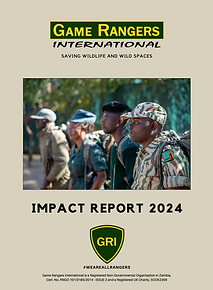
PUBLICATIONS
At GRI, we are committed to transparency, knowledge-sharing, and impact-driven conservation. Our Publications page offers a curated collection of resources that reflect the depth and diversity of our work across Zambia. From peer-reviewed scientific publications and detailed Impact Reports, this platform showcases how our mission is resonating both locally and globally. Whether you're a researcher, journalist, supporter, or conservation enthusiast, we invite you to explore the stories, data, and evidence that drive our efforts to protect wildlife, support communities, and preserve wild spaces for future generations.
2024 Impact Report

Scientific Publications

Chusyd DE et al., 2025, PeerJ
This research highlights how early-life adversity (orphaning) impacts the stress and metabolism of elephants. By comparing hormone levels and body condition of rescued orphans with wild elephants in Kafue National Park, we found that younger orphans show higher stress markers, likely due to recent trauma and lack of social bonds. Interestingly, orphans also had higher thyroid levels, suggesting good nutrition during rehabilitation, and no difference in body condition.
The findings highlight the importance of social connection and consistent care in helping orphaned elephants recover, and deepen our understanding of how poaching and human-wildlife conflict can leave lasting biological effects on wildlife.
Testing the Effectiveness of the “Smelly” Elephant Repellent in Controlled Experiments in Semi-Captive Asian and African Savanna Elephants
Robertson MR et al., 2023. Animals 13(21): 3334
This study tested a novel chilli-based “smelly” elephant repellent in controlled trials with semi-captive elephants in Thailand and Zambia. While the repellent triggered behavioural responses like sniffing, alertness, and vocalisations, it did not reliably prevent elephants from entering plots or eating food. Bolder, more playful individuals were more likely to take the risk, underlining the influence of personality on crop-raiding behaviour.
These findings raise questions about testing mitigation strategies in captive settings and highlight the need for field-based validation. The study supports combining repellents with other methods and tailoring approaches to individual elephant traits for more effective human–elephant conflict management

Gender and illegal wildlife trade: Overlooked and underestimated.
Seager, J. 2021
This research highlights how gender is a critical yet overlooked factor in understanding and addressing the illegal wildlife trade. By examining roles across the entire trade chain—from poaching to trafficking and consumption—it reveals that men and women participate in distinct but interconnected ways, shaped by cultural norms, economic pressures, and social expectations.
The findings show that ignoring gender dynamics weakens conservation efforts and risks reinforcing inequality. Recognising women’s often hidden roles and vulnerabilities, as well as the influence of masculinity on consumption and enforcement, offers new opportunities for more inclusive and effective interventions in tackling the illegal wildlife trade.

How to Protect Wildlife AND Human Health – A Transnational African Zoonosis Education Campaign
Höppner, A. & Altherr, S. (2024)
This campaign highlights how public health and wildlife conservation are deeply interconnected, and how zoonotic disease risks can be reduced through community-based education rooted in local realities. Engaging over 8 million people across four African countries it shows that health-focused messaging can drive awareness and behaviour change around the consumption and trade of wild animals.
The findings show that integrating human health into conservation outreach strengthens both outcomes. Recognising the cultural importance of practices like bushmeat consumption, while offering accessible, non-blaming education, provides a promising model for inclusive and effective zoonosis prevention. This approach demonstrates the power of the One Health framework when implemented through transnational collaboration and grassroots engagement.






